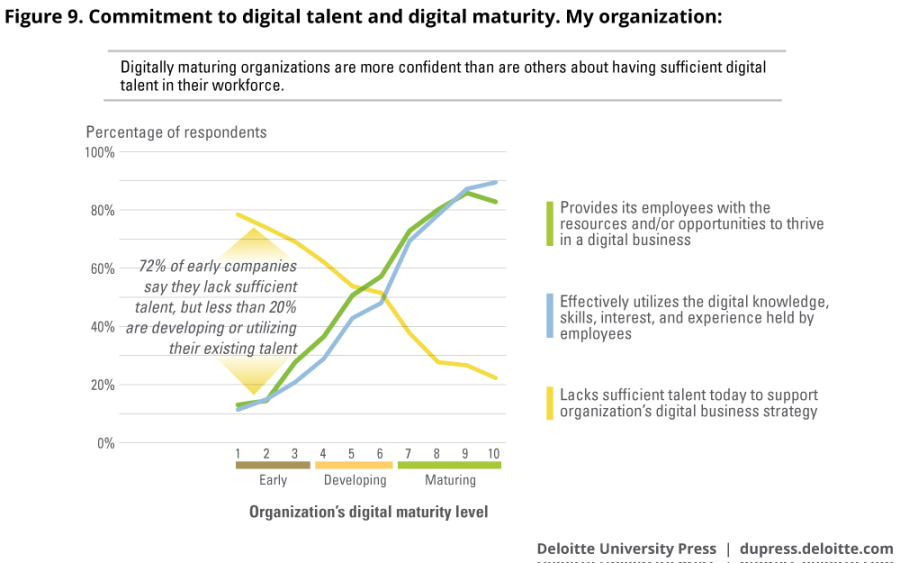Che vi piaccia o meno, l’essere digital non sarà più un vantaggio competitivo ma una caratteristica fondamentale per la sopravvivenza dell’azienda. Per questo bisogna investire in “talenti digitali” da inserire nella propria struttura.
Ma chi sono esattamente questi “talenti digital”? Dove possiamo trovarli?
Più che dei veri e propri nerd con competenze tecniche specifiche, stiamo parlando di persone che sono entusiaste del potenziale delle nuove tecnologie. Sono individui che che si organizzano, lavorano e si comportano in modo digital, sono flessibili, propensi al rischio, collaborativi e client oriented. Vogliono imparare velocemente e applicare le nuove conoscenze nel loro quotidiano, in un ambiente che sostiene questo modo di lavorare.Ci sono infatti aziende che si preoccupano di creare un ambiente lavorativo che possa attrarre questi talenti digitali, mentre quelle che non sono in linea con le loro aspettative di crescita non riescono nemmeno ad attrarli (molte volte non sanno nemmeno chi o come attrarre), tanto meno trattenerli.
Quindi, come fa un’azienda che non è ancora “digital ready” a diventarlo senza avere i talenti digital in una fase iniziale?
Investimenti nel digital
Proprio come i talenti digital, che non sono solo persone con determinate competenze tecniche, le organizzazioni possono diventare digital in modi che non implicano necessariamente la tecnologia. Si tratta di implementare una struttura, dei sistemi e una cultura aziendale che supportino e sostengano un nuovo modo di lavorare più smart e digital.
Ad esempio:
Struttura organizzativa: deve essere il meno gerarchica possibile, prediligendo una struttura più piatta per supportare un ambiente che favorisce il network e il team work.
Modello operativo: che deve dare la possibilità di abilitare il processo di digitalizzazione dell’azienda.
Strutturazione del lavoro: che deve essere sempre meno tradizionale e gararchico ma lasciare spazio a flessibilità, mobilità e lavoro in team, riducendo gradi, titoli e differenze di salario.
Modello HR: che deve evolversi in senso digitale insieme a tutta l’organizzazione. Il dipartimento HR infatti ha l’opportunità(e anche il dovere) di essere guida nell’implementazione di una cultura digital.
Come avete visto, i punti che abbiamo appena elencato non riguardano direttamente i talenti digitali, ma svolgono comunque un ruolo importante nella costruzione di un’azienda che attrae, supporta e conserva queste risorse.
Naturalmente, andrebbero anche implementanti dei programmi specifici per la transizione al digitale. Ad esempio:
Leadership development
Come state preparando i vostri leader per essere in grado di operare efficacemente in un ambiente digital? Alcuni leader sono più pronti di altri?
Pensate a come la vostra organizzazione possa costruire (o acquistare) capacità di digital leadership.Formazione
Il modo in cui il digital ha trasformato la formazione e l’apprendimento è una parte essenziale del passaggio verso questo tipo di cultura e un elemento fondamentale per poter attirare e trattenere i talenti.
Quindi, come sta procedendo la tua azienda nella digitalizzazione del processo di apprrendimento?Performance management
La tendenza è quella di misurare in modo continuativo i risultati per mantenere alto l’impegno e motivare le risorse. Feedback a cadenza regolare possono consentire alle persone di aggiornare i loro obiettivi e di sentirsi ricompensati per il loro lavoro e contributo, indipendentemente dal loro ruolo ricoperto al momento.Implementare tutti questi fattori può sembrare una sfida difficile ma ricordatevi che l’ “essere digital” è un investimento a lungo termine, una trasformazione che dovrebbe essere eseguita in modo continuo e iterativo, piuttosto che one-shot. La vostra azienda ha probabilmente alcuni elementi per la trasformazione digital già in atto, e alcune risorse che sono o potrebbero essere utilizzate come ambasciatori per contribuire ad un ulteriore spinta.
Di seguito riportiamo l’articolo originale:
Like it or not, digital is here, and in a few years, “being digital” will likely no longer be a competitive advantage for companies, but necessary for survival. With the dropping costs and rising adoption of AI, cognitive computing, and robotics, companies could easily be faced with applying these technologies everywhere, regardless of industry, function, or even company size. And that takes digital talent. But what does that mean? Who are these people? Where do we find them? They may not be who you think they are: digital talent is not strictly about “techies” and people who know how to use, build, or invest in new disruptive technologies.
And they are in high demand—a talent war more mature digital companies seem to be winning.Think of it as a mind-set and a set of characteristics more than a specific set of technical skills. Digital talent is excited about the potential of digital technologies, exponential disruption, and new ways of working. They organize, operate, and behave in a digital way. They are agile, risk takers, intentionally collaborative, and customer centric. They want to learn fast, and apply this learning and excitement in their daily work in an environment that supports and enables this way of working.
Research from MIT Sloan Management Review and Deloitte1 indicates that digitally maturing organizations2(the most mature organizations studied) take steps to cultivate digital talent and feel much more confident about having the digital talent they need, in sharp contrast to organizations that have not progressed far on their digital journey.
So, we have organizations that are committed to taking advantage of attracting and retaining digital talent, while those that are not providing the environment for digital talent to thrive and grow simply can’t attract them (many times they don’t even know who or how to attract), much less retain them.
It’s a classic chicken and egg scenario: digital talent is attracted to digital-ready organizations, but how does an organization become digital ready without digital talent?
Investing in digital
Just as digital talent doesn’t only involve talent with certain tech skills, organizations can become digital in ways that don’t necessarily involve digital technology. It’s more about establishing the structure, systems, and culture that support digital ways of working—and understanding the digital DNA traits that define how an organization is organized, operates, and behaves. For example:Organizational structure: Is your organization set up in a traditional hierarchical structure or is it flatter to support the more networked, team-based environment that characterizes the the organization of the future? Do you understand the networks within your organization and how people use them to get work done?
Organizational operating model: Does your operating model enable the digital organization you aim to be? An operating model can provide the link between organization structure and business strategy, ultimately dictating how work gets done. It can impact organization design, culture, leadership, talent, employee network, agility, and much more. (This three-part series highlights the essential role of operating model design in achieving business transformation.)
Job architecture: Traditional, structured job hierarchies were developed based on rigid frameworks and generally lack flexibility and discourage some hallmarks of digital talent, like mobility and team-based work. Implementing a flatter, more team-oriented job architecture by reducing the number of levels, titles, and pay grades in the organization can benefit companies and completely transform the employee experience.
HR operating model: In addition to setting up the organizational operating model to support digital talent, the HR operating model is also crucial. As businesses make the transition to the digital future of work, HR has the opportunity, and perhaps even the mandate, to take the lead in digital enablement across the organization. Adopting a high-impact HR operating model, thinking through the role of HR in a digital workplace, and employing design thinking to craft an “irresistible” employee experience that keeps digital talent engaged are all part of HR’s digital role.
You’ll notice that the above organizational structural elements don’t directly involve digital talent, yet play a huge role in building an organization that attracts, supports, and retains that talent.
Of course, talent programs themselves should set up be for digital enablement. For example:
Leadership development: In this year’s MIT Sloan-Deloitte digital research results, vice president-level respondents who don’t feel they have access to sufficient digital development opportunities are 15 times more likely to say they are planning to leave in one year or less than are executives who have those chances.4 How are you equipping your leaders to be able to operate effectively in a digital environment? Are some of your leaders more ready than others? Think about where and how your organization should lean in in terms of being able to build (or buy) digital leadership capabilities so you can say, “I’ve identified the gaps and have an organizational development plan in place, and I’ve identified the people I want to accelerate and how they will be developed.”
Learning: Of all the talent programs being disrupted by digital, learning may top the list, evolving from episodic events into a continuous, always-on element of employees’ daily lives. Learning transformation is an essential part of digital transformation and a key element of being able to attract and retain digital talent. Deloitte’s 2017 Global Human Capital Trends report noted that the “ability to learn and progress” is now the principal driver of a company’s employment brand. Yet only one-third of surveyed Millennials believe their organizations are using their skills well, and 42 percent say they are likely to leave because they are not learning fast enough.5 So how is your organization digitizing the learning experience? What steps are you taking
to get to digital learning?Performance management: Is the way you measure and manage employee performance helping or hindering a digital mind-set? Today’s trend is toward continuous, feedback-based performance management to maintain engagement and motivate talent. Regular feedback can empower people to reset goals continuously, change projects, and feel rewarded for their work and contribution, regardless of their particular job or role at the time.
If considering all of these factors seems like a tall order, remember that “being digital” is an investment for the long term—a transitional transformation that should be executed on an ongoing and iterative basis rather than a once-and-done event. Your organization likely has some elements of digital already in place, and some people who are or can be tapped as advocates to help advance it further. It may be that you can “rewire” parts of your organization for digital vs. a wholesale redesign. You can look to the full MIT Sloan-Deloitte research report for more insights and inspiration.


Leave A Comment
You must be logged in to post a comment.